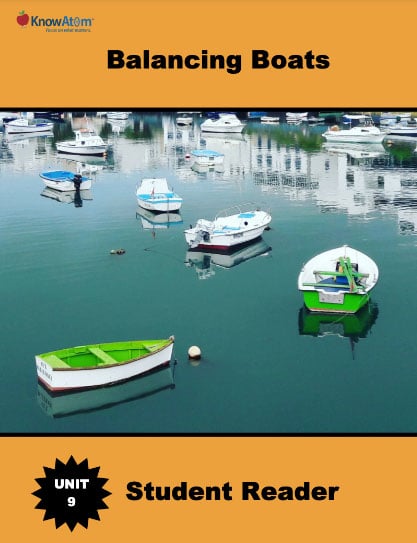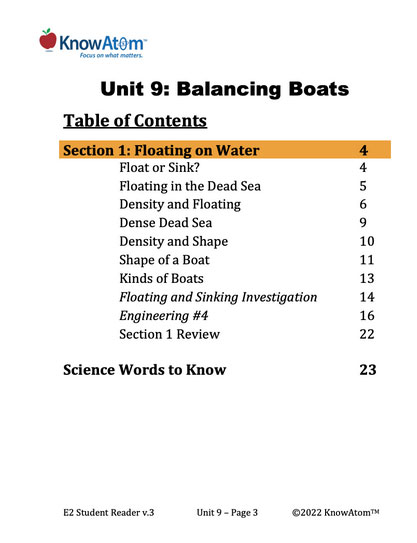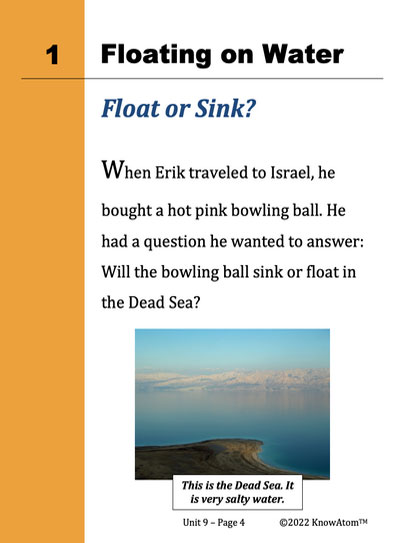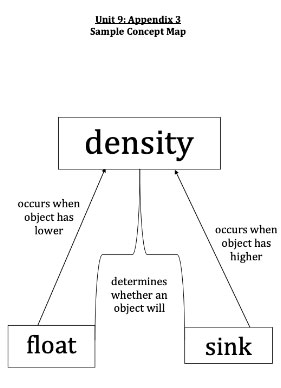In this lesson, students investigate how objects float or sink depending on their density and then investigate how changing the shape of an object can affect whether it floats or sinks.
In the last unit, students used propeller cars to explore the relationship between forces and motion. In this unit, students continue to explore vehicles with a focus on boats and specifically the science phenomena of properties that cause objects such as boats to float or sink. This page showcases parts of each element of the first lesson in this unit.
The science background gives teachers in-depth information about the science phenomena being studied by students. In this unit, students explore density by exploring what properties of objects make them float or sink.
Density is the amount of matter packed in a certain amount of space. In other words, it is a measure of the amount of mass in a given volume.
Volume is the measure of how much space a substance takes up. The more tightly packed the molecules of an object are, the denser they are. This is because they have more mass in a given volume than materials that are less dense.
Objects float when they are less dense than the fluid they are in. For example, salt water produces a greater buoyant force than fresh water because salt water is much denser than freshwater. This is why objects float more easily in salt water than in fresh water, and why a bowling ball floats in the Dead Sea.
The shape of the object also affects its buoyancy because the more surface area an object has, the more water it displaces and the more the water pushes back. This helps the object float.
In this lesson, students investigate how objects float or sink depending on their density and then investigate how changing the shape of an object can affect whether it floats or sinks.

Prepared hands-on materials, full year grade-specific curriculum, and personalized live professional development designed to support mastery of current state science standards.
Density : a property of matter; the amount of matter packed in a certain amount of space
Float : to stay above the surface of water or another fluid such as air
Sink : to drop down in water or another fluid such as air
Floating in the Dead Sea
The Dead Sea is a body of water. People come from all over the world to visit it. It is famous because it is very salty. It is much saltier than the ocean.
People float easily in the Dead Sea. To float means to stay above the surface of water or another fluid such as air.
Density and Floating
Objects float when they are less dense than the fluid they are in. Density is a property of matter. It is the amount of matter packed in a certain amount of space.
The particles of a dense object are packed tightly together. The particles of a less dense object have more space around them.
Salt water is denser than fresh water. There are more particles in a cup of salt water than there are in a cup of fresh water. Both cups of water have the same amount of water. But fresh water doesn’t have many particles of salt.



For the hands-on activity in this lesson, students investigate how objects float or sink depending on their density and then investigate how changing the shape of an object can affect whether it floats or sinks. In the first part of the investigation, students analyze the properties of different objects and then drop the objects into a water-filled test container to see if they float. In the second part of the investigation, students mold a clay ball into a shape that can float in the water. Students use the data they gathered from both parts of the investigation to construct an explanation about how the properties of an object affect whether it floats or sinks in water.
KnowAtom incorporates formative and summative assessments designed to make students thinking visible for deeper student-centered learning.

Standards citation: NGSS Lead States. 2013. Next Generation Science Standards: For States, By States. Washington, DC: The National Academies Press. Neither WestEd nor the lead states and partners that developed the Next Generation Science Standards were involved in the production of this product, and do not endorse it.